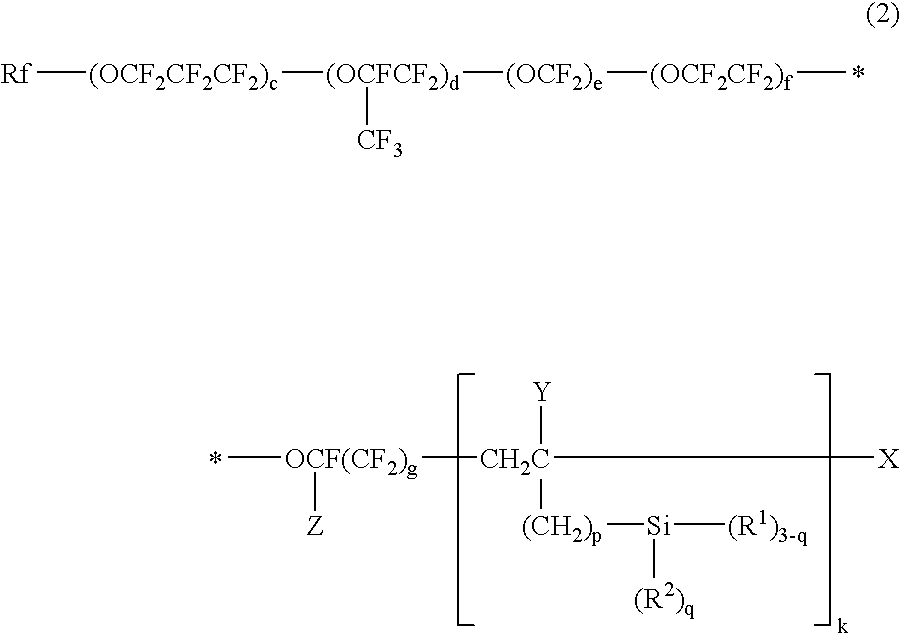Lens with stain resistant surface layer
a technology of stain resistance and surface layer, applied in the field of lenses, can solve the problems of fingerprints, hand grime, and inability to completely remove such stains by careful wiping, and achieve the effects of excellent water and oil repellency, easy wiped, and excellent durability
- Summary
- Abstract
- Description
- Claims
- Application Information
AI Technical Summary
Benefits of technology
Problems solved by technology
Method used
Image
Examples
example 1
[0053]An ethanol solution comprising 135 parts by weight of silica sol, 129 parts by weight of a partial hydrolysis-condensation product of γ-glycidoxypropyltriethoxysilane, and 70 parts by weight of a partial hydrolysis-condensation product of γ-chloropropyltrimethoxysilane was applied to a polycarbonate resin substrate (diameter: 80 mm) of thickness 2 mm, and then cured to form a hard coat layer with a thickness of approximately 3 μm. Sputtering was then used to form a multi-layered anti-reflective layer on top of the hard coat layer, comprising 5 sequential layers in a sequence represented by SiO2 layer, TiO2 layer, SiO2 layer, TiO2 layer, SiO2 layer, with the optical film thickness of each layer set to λ / 4 (λ=540 nm).
[0054]Next, a coating solution was prepared by dissolving 0.2 g of a perfluoropolyether modified silane of a compound 1 described below in 99.8 g of perfluoro(2-butyltetrahydrofuran). This coating solution was applied to the surface of the above anti-reflective laye...
example 2
[0063]0.5 g of a solution formed by dissolving 20 g of the perfluoroalkylenepolyalkyleneether modified silane of the compound 1 used in the example 1 in 80 g of perfluoro(2-butyltetrahydrofuran) was impregnated into a circular cylindrical porous ceramic pellet of diameter 5 mm and height 3 mm, and the perfluoro(2-butyltetrahydrofuran) was then volatilized and removed by standing the pellet at 70° C. for 60 minutes. The pellet was placed on top of a molybdenum boat, which functions as a resistance heater, and then mounted inside a vacuum deposition apparatus HSV-3-3G (tradename, manufactured by Sato Vac Inc.). A polycarbonate resin substrate with an anti-reflective layer and the like formed thereon from the example 1 was also mounted inside the vacuum deposition apparatus. The inside of the vacuum deposition apparatus was then evacuated down to a vacuum of no more than 5×10−3 Torr, the aforementioned boat was heated to a temperature of at least 500° C., and vacuum deposition was cond...
PUM
| Property | Measurement | Unit |
|---|---|---|
| temperature | aaaaa | aaaaa |
| thickness | aaaaa | aaaaa |
| thickness | aaaaa | aaaaa |
Abstract
Description
Claims
Application Information
 Login to View More
Login to View More - R&D
- Intellectual Property
- Life Sciences
- Materials
- Tech Scout
- Unparalleled Data Quality
- Higher Quality Content
- 60% Fewer Hallucinations
Browse by: Latest US Patents, China's latest patents, Technical Efficacy Thesaurus, Application Domain, Technology Topic, Popular Technical Reports.
© 2025 PatSnap. All rights reserved.Legal|Privacy policy|Modern Slavery Act Transparency Statement|Sitemap|About US| Contact US: help@patsnap.com



